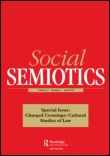
Social Semiotics
Scope & Guideline
Innovating Insights into Communication Dynamics
Introduction
Aims and Scopes
- Multimodal Communication:
Research articles frequently investigate how multiple modes of communication (text, image, sound, etc.) interact to create meaning, particularly in contemporary digital contexts. - Cultural and Political Semiotics:
The journal emphasizes the exploration of semiotic resources in cultural and political discourse, analyzing how identities and power relations are constructed and contested. - Critical Discourse Analysis:
A strong focus on critical discourse analysis allows for the examination of language and semiotic practices in relation to social justice, ideology, and representation. - Ethnographic and Contextual Studies:
Many studies incorporate ethnographic methods to understand the semiotic dimensions of everyday life, examining how people produce and interpret signs in specific cultural contexts. - Interdisciplinary Approaches:
The journal encourages interdisciplinary research, drawing from linguistics, sociology, media studies, and cultural studies to enrich the understanding of semiotic phenomena.
Trending and Emerging
- Digital Semiotics and New Media:
Increasingly, publications focus on how digital platforms and new media shape communication practices, exploring the semiotic implications of emojis, memes, and social media discourse. - Environmental and Ethical Semiotics:
Emerging themes around environmental communication and ethical considerations in semiotic practices are gaining traction, addressing the role of semiotics in sustainability and social justice. - Intersectionality in Semiotic Analysis:
There is a growing trend towards examining how multiple identity factors (such as race, gender, and class) intersect in semiotic practices, providing nuanced understandings of representation. - Globalization and Transnational Semiotics:
Research increasingly addresses the effects of globalization on semiotic practices, particularly how local cultures adapt and respond to transnational influences. - Affective and Emotional Semiotics:
Emerging interest in the semiotics of affect emphasizes how emotions and feelings are communicated and interpreted, reflecting a broader cultural shift towards understanding emotional expression.
Declining or Waning
- Traditional Linguistic Analysis:
There appears to be a decrease in publications centered solely on traditional linguistic analysis, as the journal increasingly favors multimodal and interdisciplinary approaches. - Static Representations of Culture:
Research focusing on static or monolithic representations of culture is less prevalent, with more emphasis on dynamic and fluid understandings of cultural identity. - Narrowly Defined Semiotic Frameworks:
The use of overly rigid semiotic frameworks that do not accommodate the complexities of contemporary communication practices is becoming less common, as scholars seek more flexible models.
Similar Journals

DEGRES-REVUE DE SYNTHESE A ORIENTATION SEMIOLOGIQUE
Navigating the Complexities of Language and MeaningDEGRES-REVUE DE SYNTHESE A ORIENTATION SEMIOLOGIQUE, published by DEGRES, serves as a significant platform for scholarly exploration in the fields of Linguistics and Philosophy. Fostering critical discourse and innovative ideas, this journal has been an essential resource for researchers and students alike, particularly in Belgium since its inception. Although it is indexed in the fourth quartile across its respective categories, it is notable for its contributions to the semiological methodology that intertwines language and philosophical inquiry. The journal's comprehensive archive spans from 2002 to 2014 and resumes from 2016 to 2023, providing ample content for those delving into semiotic theories and practical studies. While the journal does not offer open access, it remains a vital repository for burgeoning linguistic and philosophical research. Here, academics can engage with novel insights and enrich their understanding of the communicative processes shaping human interaction.

Cultura Lenguaje y Representacion-Revista de Estudios Culturales de la Universitat Jaume I
Bridging Disciplines Through Cultural ExplorationCultura Lenguaje y Representacion - Revista de Estudios Culturales de la Universitat Jaume I is a premier open-access journal dedicated to the exploration of cultural studies, linguistic discourse, and literary theory, published by the esteemed Universitat Jaume I. Since its inception in 2004, the journal has consistently aimed to provide a vibrant platform for interdisciplinary research and critical reflection within the fields of communication, literature, and cultural representation. With its impressive rankings in the Scopus database—placing in the 93rd percentile for Literature and Literary Theory and the 73rd percentile for Cultural Studies—this journal is recognized for its impactful contributions to academic discussions. Operated out of Castelló de la Plana, Spain, the publication not only welcomes contributions from seasoned scholars but also encourages emerging researchers to submit innovative works. By maintaining a dedication to accessibility and quality, Cultura Lenguaje y Representacion positions itself as an essential resource for scholars, practitioners, and students seeking to deepen their understanding of the intricate relationship between culture, language, and representation.

AMERICAN JOURNAL OF SEMIOTICS
Exploring the Depths of SignificanceThe American Journal of Semiotics is a pivotal publication in the field of semiotic studies, focusing on the intricate relationships between signs and meanings across various disciplines. Published by the Philosophy Documentation Center, this journal disseminates vital research and theoretical advancements that contribute to a deeper understanding of language, communication, and cultural interpretations. Although the journal has had a period of coverage in Scopus from 1996 to 2018, it continues to hold relevance with notable rankings in the Arts and Humanities and Social Sciences categories, showcasing its diverse scholarly impact. The journal aims to engage researchers, professionals, and students through a rigorous exploration of semiotic theory and its applications, reinforcing its position as a significant resource in the academic landscape.
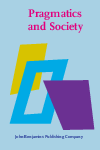
Pragmatics and Society
Bridging Pragmatics and Social TheoryPragmatics and Society, published by John Benjamins Publishing Co, is an esteemed journal that serves as a vital platform for the interdisciplinary exploration of language use in social contexts. Established with the aim of bridging the gap between pragmatics and social theory, this journal covers innovative research and critical methodologies within linguistics and language studies. With an impressive impact factor and recognition as a Q2 journal in the field of Linguistics and Language for 2023, it ranks notably within the 75th percentile for Arts and Humanities and 73rd for Social Sciences. Based in the Netherlands, Pragmatics and Society is dedicated to fostering scholarly discussions and advancing knowledge in areas such as discourse analysis, sociolinguistics, and communicative practices. Researchers, professionals, and students alike will find this journal to be an invaluable resource for understanding the complexities of language in society and are encouraged to engage with its rigorous publications.
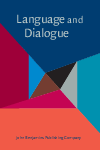
Language and Dialogue
Pioneering Research at the Crossroads of Dialogue and LanguageLanguage and Dialogue is an esteemed journal published by JOHN BENJAMINS PUBLISHING CO, focusing on the interdisciplinary intersections of language use, cultural studies, and literary theory. With an ISSN of 2210-4119 and an E-ISSN of 2210-4127, the journal has established itself as a prominent platform for high-quality research since its inception in 2011. Notably, it is ranked Q1 in Cultural Studies and Literature and Literary Theory, reflecting its prestigious standing in these fields, and has impressive Scopus rankings that further underline its scholarly impact within the arts and humanities. Based in the Netherlands, Language and Dialogue is committed to advancing the understanding of dialogue's role in language and communication, providing a vital resource for researchers, professionals, and students alike. Although not an Open Access journal, it ensures access to cutting-edge research through institutional subscriptions, making it an essential addition to any academic collection in the humanities and social sciences.
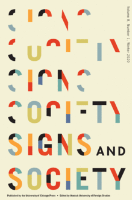
Signs and Society
Illuminating the Dynamics of Signs and SocietySigns and Society is an acclaimed academic journal published by University of Chicago Press, specializing in the interdisciplinary exploration of semiotics, cultural representations, and communication practices. With an impressive ISSN of 2326-4489 and E-ISSN 2326-4497, this journal has established itself as a credible source of research and insight within its fields. It operates under a robust framework with a convergence of topics from 2015 to 2024, and has achieved notable rankings, including Q1 placements in Cultural Studies, Linguistics and Language, and Visual Arts and Performing Arts in 2023, elevating it to a leading status among its peers. The journal’s impact is reflected in its Scopus rankings, positioning it in high percentiles across diverse categories, making it a vital resource for scholars, practitioners, and students interested in the intricate relationships between signs, society, and culture. Although not an open access publication, Signs and Society remains essential for those seeking to deepen their understanding of communication dynamics and the multifaceted dimensions of cultural expression.
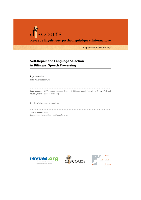
Discours-Revue de Linguistique Psycholinguistique et Informatique
Unlocking the Secrets of Language through Interdisciplinary Research.Discours-Revue de Linguistique Psycholinguistique et Informatique is a premier academic journal dedicated to the interdisciplinary fields of linguistics, psycholinguistics, and computational linguistics. Published by the prestigious UNIV PARIS-SORBONNE, MAISON RECHERCHE, this journal has been an essential resource for scholars and practitioners since transitioning to Open Access in 2007, ensuring that research findings are accessible to a broader audience. With its focus on innovative research and theoretical advancements, Discours aims to foster dialogue among linguists, psychologists, and computer scientists, promoting an integrated understanding of language as a cognitive and computational system. Located in the heart of Paris, the journal not only strengthens the academic community but also contributes to international discourse in language research. Researchers, professionals, and students alike will find valuable insights and cutting-edge findings within its pages, making it an indispensable tool for those engaged in the study of language and cognition.

Southern Communication Journal
Navigating the Landscape of Communication StudiesSouthern Communication Journal, published by Routledge Journals, Taylor & Francis Ltd, stands as a pivotal platform within the field of communication studies. With an ISSN of 1041-794X and an E-ISSN of 1930-3203, this esteemed journal has been contributing to the academic dialogue since 1988 and continues to do so through its committed coverage until 2024. Residing in the United Kingdom, the journal embraces a broad spectrum of topics within communication, providing insights that range from interpersonal communication to media studies. Notably, it is categorized in the Q3 quartile for communication in the 2023 rankings, showcasing its reputable position among peers, particularly with a Scopus ranking that places it at the 42nd percentile within the Social Sciences Communication category. Though it does not currently offer open access, the journal remains a vital resource for researchers, professionals, and students interested in deepening their understanding of communication theory and practice, exploring innovative perspectives, and stimulating scholarly exchange.
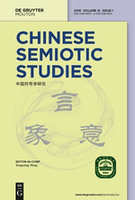
Chinese Semiotic Studies
Exploring the Intersections of Language and MeaningChinese Semiotic Studies is a pivotal journal published by DE GRUYTER MOUTON, specializing in the interdisciplinary exploration of semiotics within the context of Chinese language and culture. Established in 2009, this journal serves as a crucial platform for scholars and researchers, addressing the intricate relationships between semiotic theory, communication, and linguistic practices in China. With its current rankings placing it in the Q3 category for Communication and Q2 for Linguistics and Language, Chinese Semiotic Studies is recognized for its significant contribution to the academic discourse in these fields. Although it operates under a subscription model, the journal offers robust opportunities for knowledge dissemination and research collaboration among professionals and students alike. By fostering a deeper understanding of semiotic processes, the journal plays an essential role in advancing scholarship and innovation within the realms of linguistics and communication, making it a valuable resource for anyone interested in the dynamic interplay of language, culture, and meaning.

Biosemiotics
Unlocking the Semiotic Secrets of the Living WorldBiosemiotics, published by SPRINGER, is a leading journal dedicated to the interdisciplinary study of biosemiotics, bridging the gaps between biology, linguistics, and social sciences. Established in 2008, this journal has rapidly gained recognition in the academic community, evidenced by its strong ranking within various categories, achieving a Q1 status in Linguistics and Language and notable placements in Communication and Social Sciences as of 2023. With an impressive Scopus rank that places it in the 90th percentile among Language and Linguistics journals, Biosemiotics serves as a crucial platform for researchers and professionals exploring the semiotic processes that underlie biological communication. The journal's focus on both theoretical and empirical studies is reflected in its diverse range of articles, which contribute to the understanding of sign processes in the living world. Although it does not offer open access, its contributions are vital for advancing knowledge in biosemiotics and related fields. Located in the Netherlands, at VAN GODEWIJCKSTRAAT 30, 3311 GZ DORDRECHT, Biosemiotics continues to shape dialogues around the semiotic dimensions of life, making it an essential resource for students, researchers, and professionals alike.